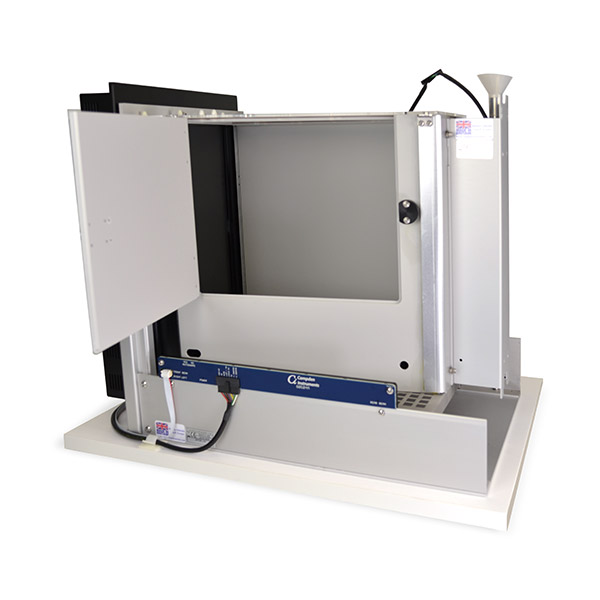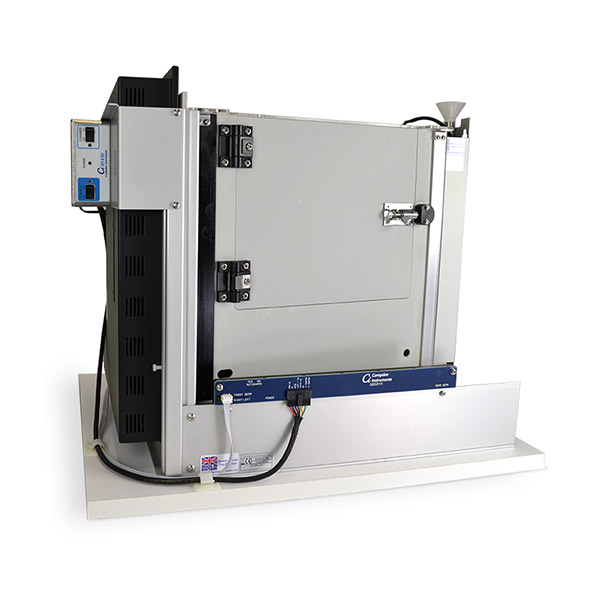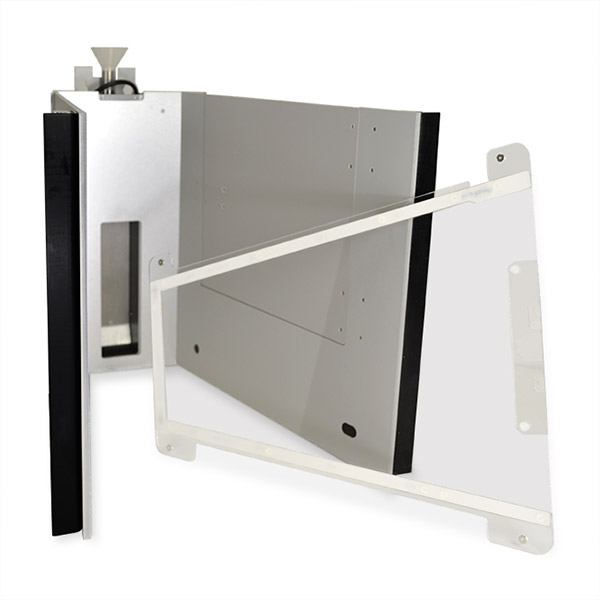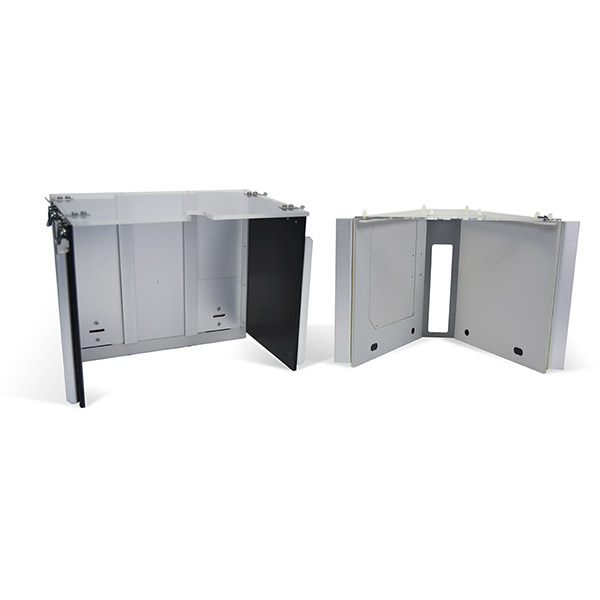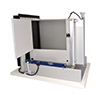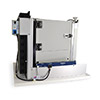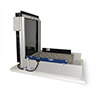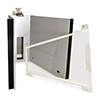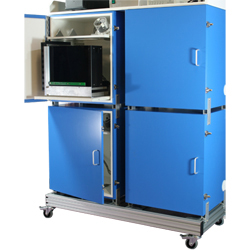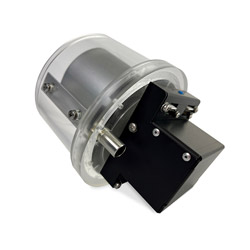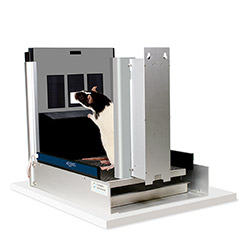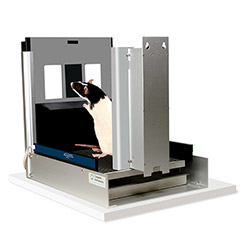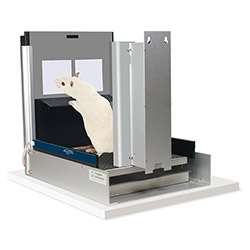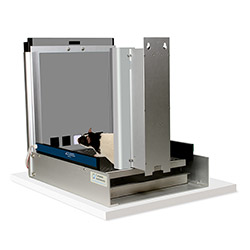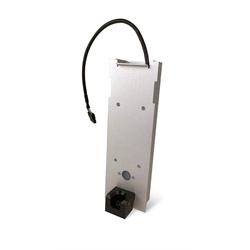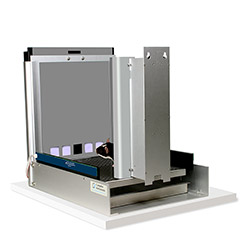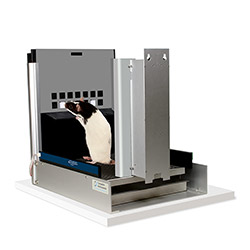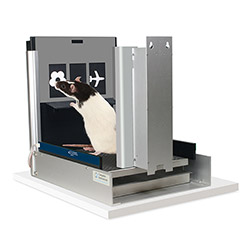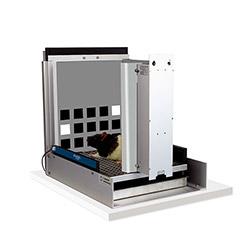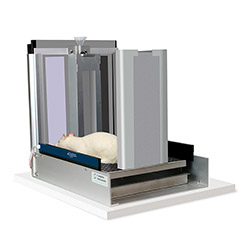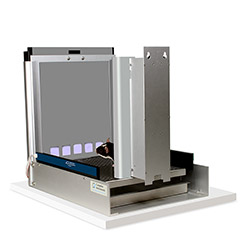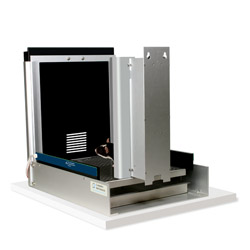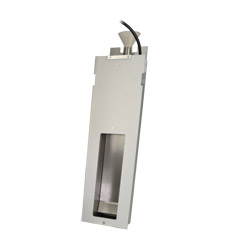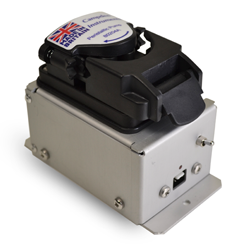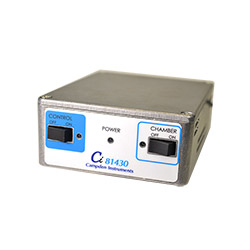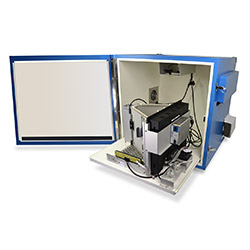A Decade of continuous development
First developed in 2009 at Cambridge University, the Bussey Saksida Rodent Touch Screen Chambers are now used by over 300 different Research Groups in at least 26 countries. The Bussey-Saksida Chamber has always featured a unique trapezoidal wall shape in order to focus the animal's attention and facilitates the efficient and high-throughput cognitive evaluation of rodents. The chamber is easily reconfigured to a modular square arena with panels, levers, lights, and a range of other operators to accommodate any task like an operant chamber equipped with a traditional lever or nose-poke.
Video
The Second Generation Bussey-Saksida chamber was built with video in mind. New non-reflective walls and floors will aid video tracking, and IR and ambient lighting located under the chamber lid provide even lighting of the chamber and eliminate glare.
Tethered Animals
Many accommodations for tethers can be made including updated lid and open reward areas to accommodate headstages. A convenient sliding drawer can be added to the environmental cabinet to neatly store and feed the tether.
Electrophysiology
All electronic components are adjusted to reduce EMC. The environmental cabinet is a Faraday cage to prevent outside noise from the surrounding area from entering the chamber. Even the touch screen itself is shielded to reduce noise emission.
Chambers Include
- Trapezoid walls in a non-reflective finish, to keep the animals focus on the screen and reducing distraction away from the screen.
- Ultra-sensitive Touch Screen to consistently detect a mouse nose-poke to the touchscreen. Commercially available touchscreens are not sensitive enough to reliably detect every nosepoke.
- A reward trough that can be place opposite or in front of the screen. While most tasks require the reward trough to be opposite the screen, some tasks (e.g. Autoshaping) require the reward in front of the screen.
- Pellet or Liquid reward.
- Activity beams to detect when the animal is at the back or front of the chamber.
- House and IR lighting
- Core Intelli-interface
Designed to be ‘plug n play’ and highly productive.
- Chambers installed on our Easy Install System, ready to wheel in your lab. Attach the PC and you are ready to go.
- Fully validated ready written Task Suites which come with training paradigms and testing guidance.
- ABET Cognition Software gives you programming power, data analysis, versatility, and flexibility; video and audio control also included.
- Virtual Interface enables the user to easily write their own scheduling and assess the data away from the lab.
- On-line training to get your lab quickly working with high productivity.
Paradigms
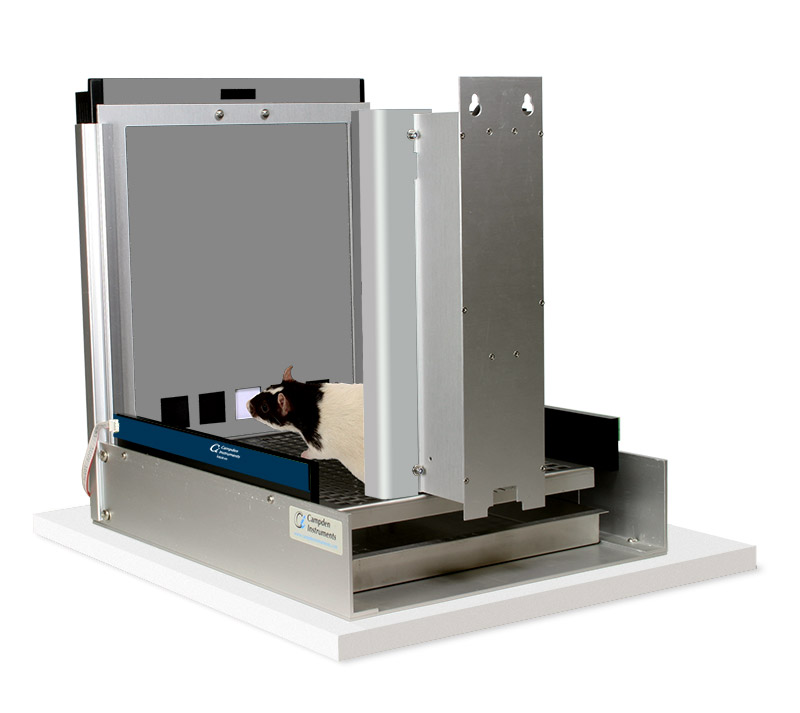
The Bussey-Saksida chamber allows usage of standard, original, and customized paradigms. Standard Task Paradigms are available by arrangement with the University of Cambridge. Standard tasks include popular Tasks such as PD, PAL, 5CSRT, PRC, Location Discrimination, and many more. The rodent tasks range from simple to complex and are virtually identical to tasks used with NHP & human populations on the CANTAB system. All paradigms include training routines as well as the main experimental paradigm and the data analysis sets.
| NHP/Human CANTAB Equivalent | Standard Tasks | Typical time to reach baseline | Example neural systems involved | Clinical area showing impairment |
| NHP | Pretraining to touch an image and initiate a trial (All task except Auto and 5CSRT) | 1-2 weeks | Learning | |
| Human/NHP | Pairwise / Visual Discrimination (PD) and Reversal Learning | Pretraining + 5-7 sessions test to reach base line | Prefrontal Cortex, Perirhinal Cortex, Anterior Cingulate, Posterior Cingulate, Medial Frontal Cortex, Striatum, Dopamine system, Cholinergic system, NMDA receptors. Mediodorsal Nucleus of the Thalamus | Huntington's, Schizophrenia, Parkinson's, Learning, Cognitive Flexibility, Executive Function. |
| Human/NHP | Paired-Associate Learning Task for Rodents (PAL) | Pretraining + 35-45 sessions to 80% | Hippocampus, Cholinergic system, NMDA Receptors, AMPA Receptors | Alzheimer's, Schizophrenia, Spacial Memory |
| NHP | Visuomotor Conditional Learning for Rodents (VMCL) | Pretraining + Approximately 20 sessions | Dorsal Striatum, Posterior Cingulate Cortex | Huntington's, Parkinson's |
| Human/NHP | 5-choice Serial Reaction Time Task for Rodents (5CSRT) | ~30 sessions | Prefrontal Cortex, Basal Forebrain, Cholinergic (Accuracy), Serotonin (Impulsivity), Noradrenaline (Distraction), Dopamine (Motivation) | Alzheimer's, Depression, Huntington's, Schizophrenia, ADHD, OCD |
| Autoshaping for Rodents (Auto) | Several sessions (no pretraining required) | Ventral Striatum, Amygdala, Anterior Cingulate Cortex, Nucleus Accumbens Dopamine, Pedunculopontine Tegmental Nucleus, D1 and NMDA receptors | Huntington's | |
| Human/NHP | Trial-unique Nonmatching-to-Location Task for Rodents (TUNL) | Pretraining + Approximately 20 sessions | Hippocampus, Cholinergic system, NMDA Receptors, Prefrontal Cortex | Alzheimer's, Schizophrenia |
| NHP | Location Discrimination for Rodents (LD) | Pretraining + 10-20 sessions | Hippocampus, Neurogenesis | Alzheimer's, Schizophrenia |
| NHP | Extinction for Rodents (EXT) | Approximately 4 sessions training + a sessions days extinction | Infralimbic Cortex, Striatum and Amygdala | ADHD, OCD |
| Human | 5-Choice Continuous Performance Test for Rodents (5C-CPT) | Approximately 24 sessions (based on training in 5-hole box) | Dopamine, Serotonin, Cholinergic, Parietal, Muscarinic. | Schizophrenia, ADHD, OCD, Alzheimer's |
| NHP | Progressive Ratio and Effort Related Choice Task for Rodents (PR/ERC) | 16 sessions from first habituation to reach stable PR performance | Dopamine | Motivation, Decision Making |
| Human | 4-Choice Gambling Task for Rodents (4C-GT) | Pretraining + 7 sessions familiarizing with choices available, then 20 sessions testing | Dopamine, Serotonin | Bipolar Disorder, Gambling, Depression, OCD, ADHD, Parkinson's, Schizophrenia, Impulsivity |
| Human/NHP | Rodent Continuous Performance Task: Image for Rodents (rCPT) | Pretraining + Approximately 30 sessions | Cholinergic system, Anterior Cingulate Cortex | Schizophrenia, ADHD, OCD, Alzheimer's |
| Human | Delay Discounting for Rodents (DD) | Pretraining + approximately 13 sessions | Dopamine | Impulsivity, ADHD |
| NHP | Probabilistic Reversal Learning for Rodents (PRL) | Pretraining + Approximately 17 sessions | Serotonin | Depression |
Features
- Write your own Tasks or use the 14 pre-written validated Tasks currently available, including all training paradigms as a turn-key solution.
- Easier animal handling with side or top loading as standard.
- Door with magnetic catches for quiet operation.
- Lower cost and more robust construction.
- Walls now in a lighter color that provides better contrast for the camera to capture the animal’s image or contour when tracking.
- Reward trough has a ‘pellet retrieval’ and dual liquid feed options plus a wider aperture to accommodate head-staged animals. Two alternative front plates offering different aperture heights as standard.
- Modular design to minimize reconfiguration to accommodate tethered animals and/or electrophysiology recording.
- The chamber floor is now matted to reduced glare from the house-light, again for better consistent image capture by a camera for observation or tracking.
- Easier access to remove the floor for cleaning.
- These new non-reflective walls and floors will aid video tracking, for those customers seeking the extra information this can provide.
- IR and ambient lighting located under the chamber lid provide even lighting of the chamber whilst eliminating glare from the lid interfering with the camera picture.
- For Integration with electrophysiology, all contact points between animal and chamber (floor, reward trough etc) have optional electrical isolation coating to prevent movement artefacts occurring.
- IR tracking beams now have an instant test facility as well as improved sensitivity and longevity
- Optional square modular walls to add levers and other modules if required.
- Slotted lids for tethered animals.
- Shockable floor
- Integration with other measures such as Optogenetics, Photometry, Video Tracking and Electrophysiology Recording.
- Third party systems can be integrated with TTL input and output lines, with low e.m.c. noise 80604EA chambers for integrating with Electrophysiology Recording
Specifications
Animal Working Area
- 126mm width at Feeder
- 240mm width at Screen x 332 mm Deep (607.6 Sq. cm or 94.17 Sq. in)
- Working Area is 300mm in Height
Standard Environment Cabinet
- Attenuation: Approx. 35dB
- Weight: 38 kg (empty)
- External Dimensions: 600mm Wide x 670mm Tall x 352mm Deep
- Internal Dimensions: 540mm Wide x 610mm Tall x 532mm Deep
Science
The Touch Screen has been used to develop a wide range of tasks, probing different areas of cognition, most of which are available ready written with programs and information to train the rodents to the task.
The design of the Touch Screen chamber and the tasks were both found to be crucial to get good and consistent results - comparable results have been achieved by labs all over the world using the Lafayette/Campden Touch Screen and these prewritten tasks. Implementation of the smooth trapeziodal walls and extra sensitive Touch Screens significantly reduced the training times and rodent performance – minimizing distraction and making sure all nosepokes to the screen are detected.
As well as being able to compare results with other rodent Touch Screen work, the chambers also lend themselves to comparing with both NHP and Human Touch Screen Tasks.
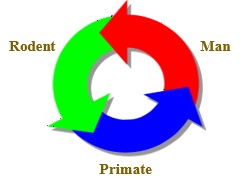
Translational Science
Human CANTAB was developed at Cambridge University, UK, from well-known animal models of behaviour. This has allowed the development of a range of cognitive tests proven to be sensitive to specific regions of the brain. These language free Human CANTAB tests have been further developed to make them suitable for monkey studies - incorporating as few changes as possible.
Monkey CANTAB was developed by a group including Drs T.W. Robbins and A.C. Roberts at the Department of Experimental Psychology, University of Cambridge, England, to improve the comparative assessment from animals to humans. The result is a battery of tests that can be used to study cognition in both experimental primates in the laboratory and humans in the clinic. Link to Monkey CANTAB Page
Professors Tim Bussey and Lisa Saksida at the Cognitive Systems Neuroscience Laboratory, University of Cambridge, England have also developed rodent touchscreen chambers and tasks for rats and mice to again find tasks that are translational to human cognitive tests.
An important consideration in the development translational tasks has been to maximise the likelihood that the same cognitive abilities are used by both animals and humans to perform each test. Consequently, complex tasks are broken down into their constituent elements and each element assessed independently of the next in a step-by-step progression through the test. Guiding a subject through the test in this way restricts the use of alternative strategies and permits an analysis of performance in terms of the cognitive components involved. Functional equivalence is suggested if the pattern of performance of animals and humans, at each stage of the test, is qualitatively similar and if comparable impairments are seen following damage to selective brain structures. A growing bibliography is building evidence that this is the case.
Key Paper - Touchscreen cognitive testing: Cross-species translation and co-clinical trials in neurodegenerative and neuropsychiatric disease, Palmer et al, Neurobiology of Learning and Memory, 2021, 107443.
One case in point concerns the Paired Associate Learning Task (PAL). In human studies early onset Alzheimer’s patients have shown significant deficiencies on this task. Humans with a DLG2 mutation have been found to be impaired on PAL. Likewise DLG2 knock out mice show impairment as shown here. [Nithianantharajah et al, Nature Neuroscience, 2013, 16]
Several strains of rats and mice have been used in the touchscreen chambers, including transgenic and knock out animals.
In a Lab Animal Review article it is also argued that the translational nature the tasks, the lack of aversive stimuli and the wide range of psychological constructs that can be evaluated, means the touchscreen method can yield significant 3Rs (Replacement, Reduction and Refinement) benefits.
